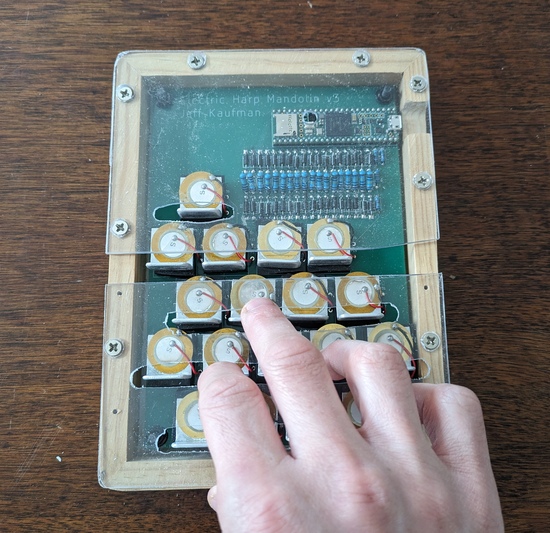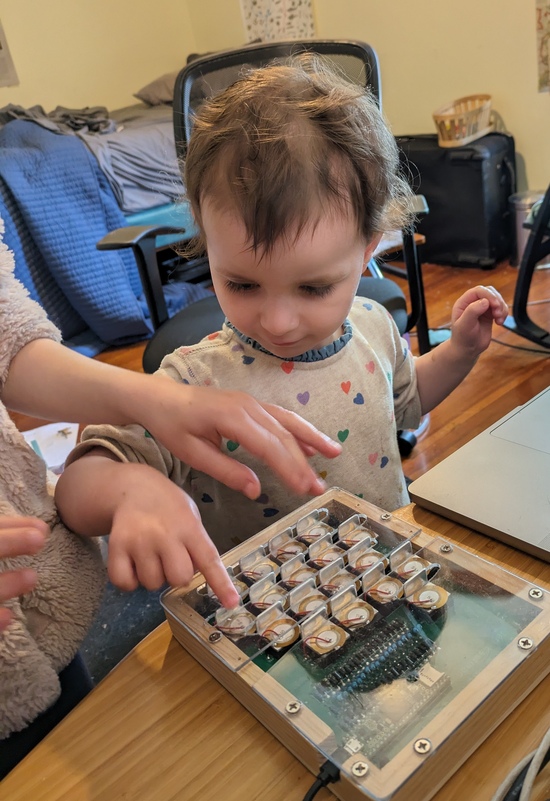Accidental Electronic Instrument |
May 5th, 2024 |
| emandoharp, music, tech |
It's not what I was going for! Instead of a small bisonoric monophonic picked instrument attached to the mandolin, it's a large unisonoric polyphonic finger-plucked tabletop instrument. But I like it!
While it's great to have goals, when I'm making things I also like to follow the gradients in possibility space, and in this case that's the direction they flowed.
I'm not great at playing it yet, since it's only existed in playable form for a few days, but it's an instrument it will be possible for someone to play precisely and rapidly with practice:
This does mean I need a new name for it: why would you call it a "harp mandolin" when it has nothing to do with a mandolin and little to do with a harp?
While you play it totally differently, the instrument it feels most similar to me is a hammered dulcimer. You can play quite quickly, and the only information you're producing is the note selection, the timing, and the initial velocity. It also makes me wonder whether this would pair well with a damper pedal, reasonably common on hammered dulcimers, to allow you to mark the ends of notes? My feet are already allocated, but perhaps a strip running along the left hand side, for your thumb, would do this well?
On the construction side, some things I've learned:
Having the 'teeth' directly on the circuit board simplifies things a lot, and avoids having to mess with wires and worry about how stressed the connections are.
But there's also a right order to assemble. Initially I tried to glue up the sensors, then attach them to the board, then connect them electrically. And then I broke a bunch and couldn't remove them. Instead, what worked well the second time was soldering on just the piezos first, then putting on the rubber and metal once I'd tested that the whole board was working.
Acrylic is a nice surface for the top because it's thin and you can see how it works inside, but there's not much reason to use it for the back and it's a finicky material.
The box is essentially a picture frame, so following advice for picture frame making works well.
If you make the box exactly the size of the PCB then it's almost certainly going to be too small somewhere. I had to discard an initial version of the case.
The distance between the bottom of the lid and the tops of the sensors is critical. If it's too low then they bump, but too high means there's not enough tooth to pluck. Instead of trying to make the walls exactly the right height, though, things got easier when I made them too tall and then raised the board with washers until it was exactly right.
Clean things before final assembly. The underside of my top acrylic is dusty, but while it annoys me a little it's not enough that I want to take the screws back out. Of course I don't always know I'm doing final assembly until it's too late.
I have four more of the circuit boards if anyone else would like to put one together. I'd be happy to include the diodes, resistors, and piezos, which are super cheap. You'd need to supply a teensy 4.1, and make the teeth (1/16" aluminum angle, 3/4" x 1/2", which you cut and shape).
I do still want to explore the mandolin-mounted version at some point, but it's mostly dependent on figuring out how to make much smaller sensors. This model is a good spacing for fingers, but for picking I want something with the horizontal spacing of frets and the vertical spacing of strings: about 3/8" by 3/8".
Comment via: facebook, lesswrong, mastodon, substack

